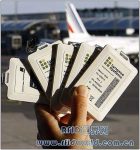
Copenhagen Airport uses RFID and Bluetooth to reduce flight delays
[ad_1]
The modern airport covers a large area, with a large number of shops, restaurants and other entertainment facilities. Although this provides convenience for passengers, it also means that passengers have to walk a long distance to reach the boarding gate from the middle area of the terminal.
At Copenhagen Airport, approximately 4% of aircraft delays are caused by passengers failing to arrive at the gate on time. In order to reduce this situation and also help plan the distribution of retail stores, Copenhagen Airport is now testing an RFID system that combines active RFID and Bluetooth mobile phone technology to track the location of passengers in the terminal. If it detects that some passengers are still far away from the boarding gate when their flight starts to board, the system will notify them via mobile phones.

The Gatecaller RFID system uses a credit card-sized, battery-powered RFID tag to transmit data at 433.92 MHz
This Gatecaller RFID system uses a credit card-sized, battery-powered RFID tag to transmit data at 433.92 MHz. Passengers receive the tag when checking in, and return it to the staff when boarding. The Gatecaller system was developed by an RFID association sponsored by the Danish government, which includes Lyngsoe Systems Copenhagen Airport, Copenhagen IT University Blip Systems and the Riso National Laboratory.
The association is now undertaking a three-year SPOPOS project to develop and test personnel and item tracking technology. The project has been halfway through so far. The Danish government contributed US$2.7 million to sponsor the project.
On March 15, Scandinavian Airlines (SAS) participated in the field test of the system. SAS issued RFID tags (provided by Lyngsoe) to 106 passengers on a flight, and then registered their names and mobile phones. The association installed RFID readers provided by Lyngsoe and Bluetooth transponders provided by Blip Systems at 25 important access corridors in the terminal building to track passengers passing by these points.
“For SAS, it is clear that we must participate in such a project that can make flight operations more efficient and smoother,” said airline spokesperson Mikkel Londahl. “We are fairly confident that this technology can help us achieve more punctual departures.
According to Henrik Bjorner Soe, marketing manager at Copenhagen Airport, the RFID system will reduce the pressure on passengers and further achieve the goal of a “quiet” airport – that is, there is no need to frequently call passengers on the broadcast system. “We have more than 300 announcements every day calling for passengers to arrive at the gate,” Soe said. “This is because we don’t know which passenger is closer to the gate and which is farther from the gate.”
After adopting the RFID system, when a flight is ready to board, the system uses red, yellow, and green to represent the passengers on a computer map according to the distance between the passengers and the boarding gate. Those passengers who are close to the correct gate are shown as green dots; the yellow dots mean they are a little away from the gate, but they can still arrive on time. Then the system calls or sends text messages to the yellow dot passengers to inform them of their upcoming flight; red dots It means that passengers who cannot arrive at the boarding gate on time, if necessary, the staff will withdraw the customer’s luggage from the original flight and start rebooking the flight for them.

This system allows the airport to know the location of passengers in real time. Project leader John Paulin Hansen said that the airport staff can be adjusted according to the actual situation.
Paulin Hansen said that the Copenhagen Airport project is the first case he knows about combining RFID and Bluetooth technology, and the two technologies complement each other. Paulin Hansen said, “As a result, we have achieved 100% passenger tracking accuracy, and passengers using Bluetooth phones can also receive location services, such as TravelMate (which can provide them with customized location data).
In addition, in addition to avoiding flight delays, the airport can also use passenger data to analyze the airport’s passenger flow distribution and to plan the location of restaurants and shops. “We can learn about the time people spend in a specific area, the time they spend in the store, and what they spend. There are many opportunities in this.”
The operating software of the Gatecaller system is based on a database developed by Lyngsoe, which uses a web interface to allow users to track the location of passengers in real time. Although the system currently tracks passengers with an accurate range of 100 meters * 100 meters, the system may still achieve more accurate tracking.
According to a survey conducted by Copenhagen Airport, passengers are very interested in real-time location tracking on the Internet because they can track family members, such as small children and elderly people traveling alone.
Although the Gatecaller project is still in the demonstration stage, Paulin Hansen expects that this system will eventually be officially launched in Copenhagen and other airports. “Every medium and large airport will be interested in this kind of system,” he said. “If we can record the specific number of disturbances that reduce flight delays, or allow passengers to pay for the service, then this will be a good business model.”
[ad_2]





